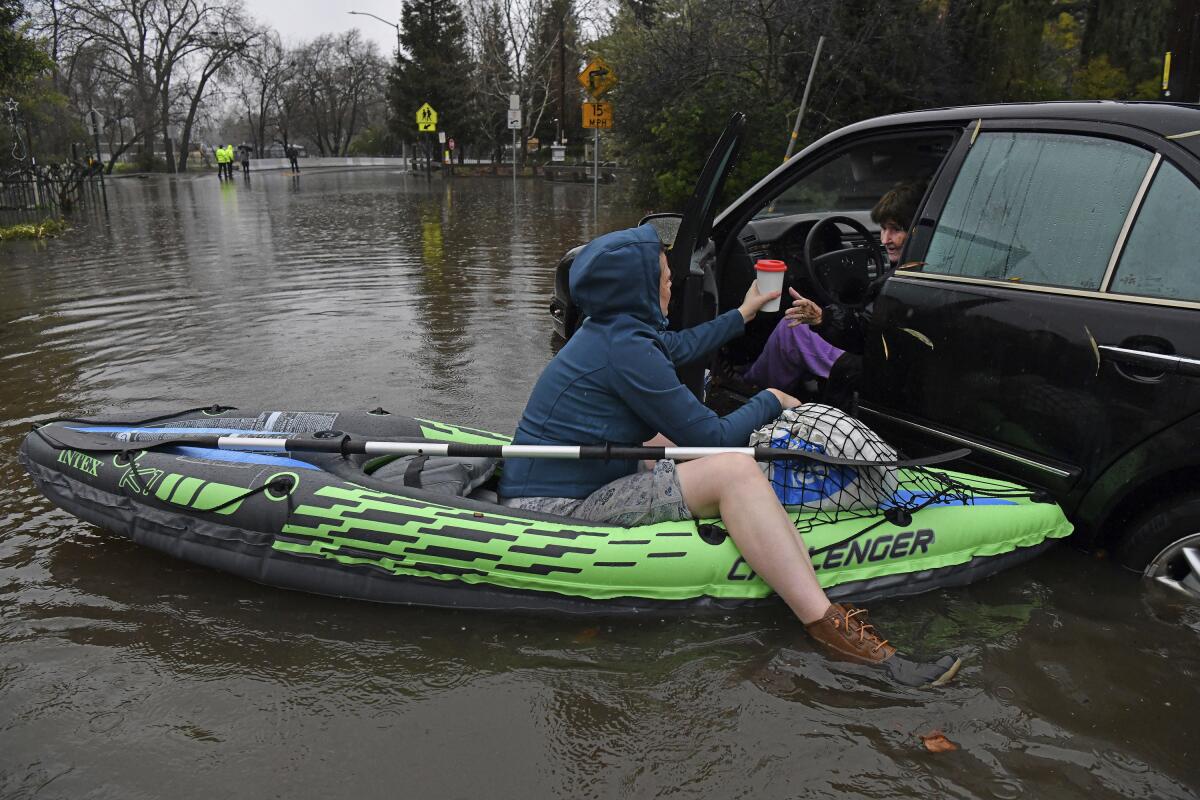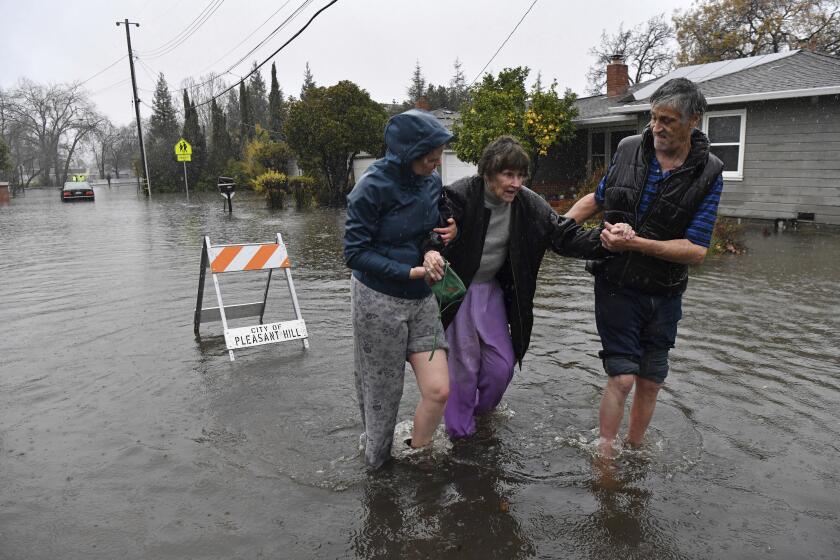Another major storm to slam California, heightening dangers in battered NorCal

- Share via
After a powerful New Year’s Eve storm slammed the state, forecasters are warning Californians to prepare for another “brutal” weather system that could bring widespread flooding starting midweek.
After a weaker storm that moved in Monday, forecasters are focused on an atmospheric river that’s expected to bring heavy rain and strong winds Wednesday and Thursday.
In the Sacramento Valley and northern San Joaquin Valley, forecasters are expecting at least 2 inches of rain, with upward of 3 inches in some places. The foothills could get anywhere from 2 to 5 inches of rain, said Scott Rowe, a meteorologist with the National Weather Service in Sacramento.
A flood watch will be in effect for virtually all of the Sacramento Valley from Wednesday to Friday mornings.
“The flood threat is going to be renewed at least at this point from an urban standpoint, with folks that live in city limits, with poor drainage, low-lying areas, low-lying roads, those are some of our primary concerns right now,” Rowe said.
The midweek storm follows one that hit over the weekend and left tens of thousands of homes in Northern California without power for much of Sunday. Record high water levels on the Cosumnes River near Sacramento breached three levees and inundated the area.
Flash flooding along Highway 99 and other roads south of Sacramento submerged dozens of cars near Wilton, where the water poured over the levees. Search-and-rescue crews in boats and helicopters scrambled to pick up trapped motorists. At least one person was found dead in a submerged car near Dillard Road and Highway 99, according to local media reports.
Thousands of residents were still dealing with power outages in the Sacramento area as of Monday morning, according to the Sacramento Municipal Utility District.
“We already have set the stage with the flooding from this last week. We’re entering this storm with a whole new different set of circumstances,” Rowe said Monday. “Everything is already wet and well saturated in many instances. It’s definitely a situation that we’re watching very carefully.”
An atmospheric river pummeled Northern California on New Year’s Eve as another Pacific storm moves in to drench the state later this week.
The brunt of the New Year’s Eve storm fell on Northern California.
In San Francisco, 5.46 inches of rain fell, making Saturday the city’s second-wettest day in more than 170 years, the National Weather Service reported.
The 101 Freeway in South San Francisco was shut down for flooding just as New Year’s Eve revelers were heading out to celebrate, but it reopened a few hours before midnight.
Forecasters are warning that the Bay Area could be hit hard once more this week.
The Bay Area office of the National Weather Service warned of catastrophic impacts across the region, including “widespread flooding, roads washing out, hillsides collapsing, trees down (potentially full groves), widespread power outages, immediate disruption to commerce, and the worst of all, likely loss of human life.”
“To put it simply, this will likely be one of the most impactful systems on a widespread scale that this meteorologist has seen in a long while,” the statement read. “This is truly a brutal system that we are looking at and needs to be taken seriously.”
Starting Wednesday, the Bay Area could see 2 to 4 inches of rain in the lower elevations, with 3 to 6 inches in the coastal hills, said Ryan Walbrun, a weather service meteorologist in Monterey.
“For most of the area, it’ll be similar rainfall or even slightly stronger than what we saw on New Year’s Eve,” he said.
Flood watches and high-wind watches have been issued for much of Wednesday and Thursday for the entire Bay Area, Walbrun said. Wind gusts will be in the 50- to 60-mph range.
With soil already saturated from the weekend storm, Walbrun said, “it just makes it that much easier for trees to come down.” And with rivers and creeks already running higher, “there’s just less capacity to hold all the new water.”
“Much of the Bay Area was hit pretty hard New Year’s Eve and is still kind of recovering from that,” Walbrun said. “We expect this to exacerbate the situation.”
With Tuesday expected to be a “break day” for the region, with dry weather, Walbrun urged residents to spend that time preparing for the approaching storm.
“Tuesday, that’s kind of like your last day for basic preparation. Sandbagging, preparing for power outages,” he said. “I think we can use what we saw on New Year’s Eve as a baseline and expect similar impacts with this Wednesday, Thursday storm.”
Some cities were already preparing Monday.
In Palo Alto, city staff removed mud and debris from streets near a creek affected by flooding. The city of Watsonville, in Santa Cruz County, set up sandbag stations, prepared a park to serve as a shelter in case of evacuations and had crews cleaning areas hit by flooding.
Walbrun warned residents that more strong weather systems are expected this weekend and into next week.
“The storms really are lined up, so there’s just not going to be much recovery period,” he said. “We’ve got to be in for the long haul here, [because] it does look like we have two or three more storms after this Wednesday, Thursday one.”
In Los Angeles, where heavy rain fell on New Year’s Eve, forecasters expected light rain on Monday afternoon, totaling a quarter to half an inch.
But then “attention really shifts to the Wednesday, Thursday storm, which looks like it’s going to be the strongest of the season,” said David Sweet, a meteorologist at the National Weather Service in Oxnard.
On Wednesday, an initial frontal system will bring maybe 1 to 2 inches of rain across the area, with slightly higher amounts in the mountains, Sweet said.
The main storm system, he said, will arrive Wednesday night and into Thursday, bringing with it very heavy rain. Rainfall totals could be anywhere from 2 to 5 inches in the lowest elevations and 5 to 8 inches in the mountains, he said.
“Damaging winds and flooding would be the main concerns with this particular system,” Sweet said. “It’s going to be a challenging couple of days.”
The storm could also bring winds of 50 mph and would be “very capable of bringing down power lines, trees, tree branches” and causing possible damage in some areas, he added.
There are possible additional storms next week, although those systems will probably focus more on areas north of Los Angeles County, Sweet said.
With wind-chill temperatures expected to be below 32 degrees, the L.A. County Department of Public Health issued a cold weather alert this week. The alert will be in effect on Mt. Wilson on Thursday and in Lancaster Tuesday, Friday and Saturday.
“Children, the elderly and people with disabilities or special medical needs are especially vulnerable during cold weather,” Dr. Muntu Davis, Los Angeles County’s health officer, said in a statement. “Extra precaution should be taken to ensure they don’t get too cold when they are outside.”
Though California’s drought remains far from over, the wet weather that closed 2022 has enabled at least a few of the state’s major reservoirs to exceed their historical average water supply.
“After years and years of drought, this could provide some relief to that,” Sweet said. “It’s just unfortunate we’re getting so much all at once.”
More to Read
Sign up for Essential California
The most important California stories and recommendations in your inbox every morning.
You may occasionally receive promotional content from the Los Angeles Times.












